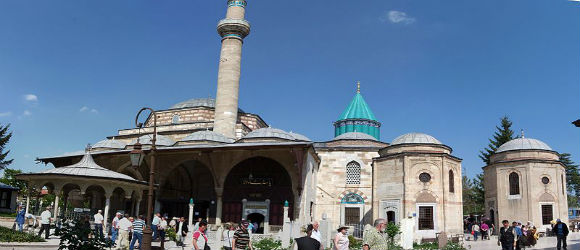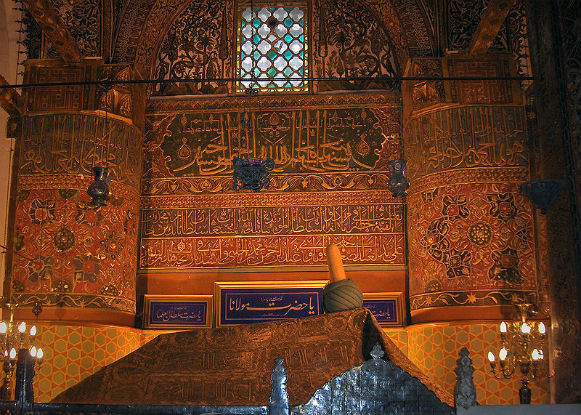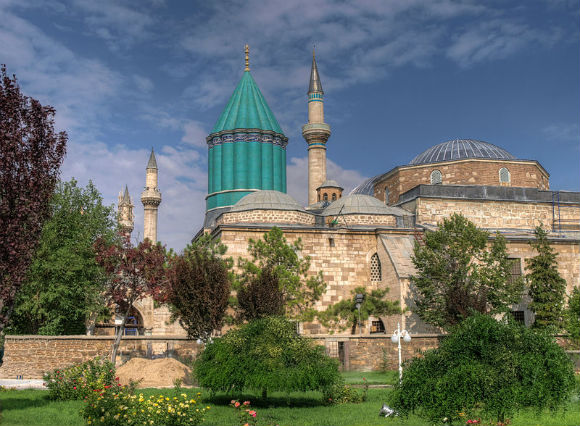The Mevlana Museum also known as the Green Mausoleum or Green Dome, is the original lodge of the Mevlevi Whirling Dervishes, a mystical Sufi Muslim group. It containes the tomb and shrine of the Mevlana, or Rumi, which remains an important place of pilgrimage.
History
Sultan ‘Ala’ al-Din Kayqubad, the Seljuk sultan who had invited Mevlana to Konya, offered his rose garden as a fitting place to bury Baha’ ud-Din Walad (or Bahaeddin Veled), the father of Mevlana, when he died in 1231. When Mevlana himself died on December 17, 1273, he was buried next to his father.
Mevlana’s successor Hüsamettin Çelebi built a mausoleum (Kubbe-i-Hadra) over the grave of his master. The Seljuk construction, under architect Behrettin Tebrizli, was finished in 1274. Gürcü Hatun, the wife of the Seljuk Emir Suleyman Pervane, and Emir Alameddin Kayser funded the construction.
The cylindrical drum of the of the dome originally rested on four pillars. The conical dome is covered with turquoise faience. Several sections were added until 1854. Selim I decorated the interior and performed the woodcarving of the catafalques.
A decree by Ataturk in September 1925 dissolved all Sufi brotherhoods in Turkey. On April 6, 1926, another decree ordered that the Mevlana mausoleum and dervish lodge be turned into a museum. The museum opened on March 2, 1927.
Special permission granted by the Turkish government in 1954 allowed the Mawlawi dervishes of Konya to perform their ritual dances for tourists for two weeks each year. Despite government opposition the order has continued to exist in Turkey as a religious body. The tomb of Rumi, although officially part of a museum, attracts a steady stream of pilgrims.
What to See
The dervish lodge (tekke) includes a semahane, where the ritual sema or whirling ceremony takes place, a sadirvan for ritual ablutions, a library, living and teaching quarters, and the mausoleum housing the tomb of Celaleddin Rumi, founder of the sect and later awarded the honorable title of Mevlana. His epitaph reads: “Do not seek our tombs on this earth – our tombs are in the hearts of the enlightened.”
The mausoleum room is highly ornamented with Islamic script and enameled reliefs, and contains the tombs of several of the more important figures of the dervish order. The main tomb enclosed behind a silver gate crafted in 1597 is that of Mevlana. The tomb of his father, Bahaeddin Veled, is upright and adjacent to his son’s, a position that signifies respect.
The adjoining room, or the semihane, is now a museum of Mevlana memorabilia displaying musical instruments and robes belonging to Mevlana, along with Selçuk and Ottoman objects like gold-engraved Korans from the 13th century. Among the fabulous ancient prayer rugs is the most valuable silk carpet in the world.
Mevlana Museum, Konya,




With over 1.5 million visitors a year, the museum and surrounds were very busy, even in late October. Buses from throughout Turkey and Iran were constantly stopping and spending about an hour at the site.
We found the tomb of Rumi so packed we spent more time in the gardens and quieter areas. There is quite a deal of history…
This was a treat of traditional Turkish Ottoman style. The chandeliers were dazling. I loved seeing the ancient Korans and the books written by Mevlana. It was very moving to see how many Turkish people had tears in their eyes as they moved past the tombs and gazed upon the relics. This is indeed a holy site, and despite the…
It was a great place to get insight into the history of the Mevlana, sad about not being able to take photos in certain areas
Some very impressive architecture set in a lovely garden setting.
Large numbers of noisy schoolchildren, large groups who feel they don't have to wait their turn.
No warning of closing but a sudden herding of everyone back through the turnstiles. A fair number of 'youths@ hassling you once outside
The grounds full of fragrant roses, the museum with its gorgeous tiles and history, the cleanliness of the grounds and the helpfulness of the people were all part of what we enjoyed and will remember fondly.
The view of the tumb of Mevlana is spectacular. The calligraphy on the walls, the colors are beautiful. If you are in Konya, this is one attraction not too miss.
So much Turkish history here. One gets goosebumps looking at hand-written copies of the Koran done in the 12th century. Many artifacts as well as a history of "The Whirling Dervishes."
A must see for Konya visitors.
The Mevlana Museum is a series of little mosque-like structures containing different collections. In one, a diorama type display showing the famed Whirling Dervishes and their sacred ritual. In another, the mosque with its ornate paintings and collection of miniature art. I loved the miniature art display, but in general I felt the mosque to be a bit stifling and…
This museum was wonderful. The little cells all around the courtyard give a glimpse into what the life of one of the people there would have been like. The actual mosque with the tombs in it is fascinating. One caveat – there is only one Western style toilet cubicle, so ladies, be prepared to squat if you need to go.
It was amazing. Of course a must see attraction for Konya but please learn something before you visit there. And give some respect.